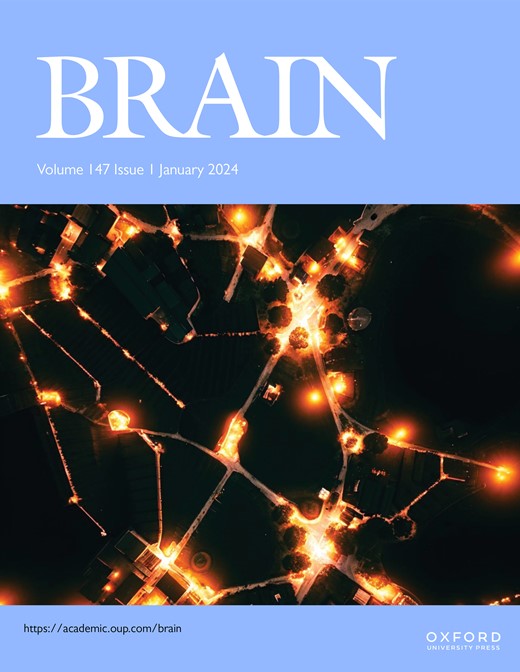CSF proteomics of semorinemab Alzheimer’s disease trials identifies cell-type specific signatures
IF 10.6
1区 医学
Q1 CLINICAL NEUROLOGY
引用次数: 0
Abstract
Targeting of tau pathology has long been proposed as a potential therapeutic strategy for Alzheimer’s disease (AD). Semorinemab is a humanized IgG4 monoclonal antibody that binds to all known isoforms of full-length tau with high affinity and specificity. Semorinemab’s safety and efficacy have been studied in two Phase 2 randomized, double-blind, placebo-controlled, parallel-group clinical trials: Tauriel (prodromal-to-mild AD; NCT03289143; in which semorinemab failed to demonstrate clinical efficacy) and Lauriet (mild-to-moderate AD; NCT03828747. However, semorinemab was associated with a significant slowing in progression in a co-primary endpoint of cognition only in Lauriet but not in Tauriel. Proteomic profiling of CSF collected in these trials was performed to gain a better understanding of the effect of semorinemab in light of the different clinical outcomes. CSF was collected from a subset of patients at baseline and after 49 or 73 weeks in Tauriel and baseline and after 49 or 61 weeks in Lauriet. Samples were analyzed using single-shot FAIMS-DIA-MS and analyzed with Spectronaut and MS Stats. Proteomics results were integrated with publicly available single-nucleus brain datasets to contextualize cellular expression profiles of differentially expressed proteins. A novel proteomics dataset was generated using more than 250 cerebrospinal fluid (CSF) samples where more than 3500 proteins were detected. Treatment-associated proteomic signatures were defined for each clinical trial as the set of proteins significantly elevated in the treatment arm in the respective trial. Integration of the corresponding gene signatures with brain single-nucleus RNA-seq datasets from AD and healthy age-matched controls revealed that the Lauriet signature genes were enriched in microglia, while Tauriel signature genes were more broadly expressed across brain cell types. Furthermore, the Lauriet gene signature was significantly upregulated in microglia from AD patients compared to non-demented controls. The elevation of proteins such as CHI3L1 and GPNMB with treatment suggested an activated glial state. This study demonstrates the utility of CSF clinical proteomics to assess the pharmacodynamic response of semorinemab and contributes to our understanding of how an anti-tau antibody influences disease-relevant pathophysiology in AD.semorinemab阿尔茨海默病试验的脑脊液蛋白质组学鉴定细胞类型特异性特征
长期以来,靶向tau病理被认为是阿尔茨海默病(AD)的潜在治疗策略。Semorinemab是一种人源化IgG4单克隆抗体,具有高亲和力和特异性,可结合所有已知的全长tau亚型。Semorinemab的安全性和有效性已经在两项2期随机、双盲、安慰剂对照、平行组临床试验中进行了研究:Tauriel(前驱至轻度AD;NCT03289143;其中semorinemab未能显示临床疗效)和Lauriet(轻度至中度AD;NCT03828747。然而,semorinemab仅在Lauriet中与认知的共同主要终点进展显著减缓相关,而在Tauriel中则没有。对这些试验中收集的脑脊液进行蛋白质组学分析,以便根据不同的临床结果更好地了解semorinemab的作用。在基线时、Tauriel治疗49周或73周后、Lauriet治疗49周或61周后收集一部分患者的脑脊液。样品采用单次FAIMS-DIA-MS进行分析,并使用Spectronaut和MS Stats进行分析。蛋白质组学结果与公开可用的单核脑数据集相结合,以确定差异表达蛋白的细胞表达谱。使用250多个脑脊液(CSF)样本生成了一个新的蛋白质组学数据集,其中检测到3500多种蛋白质。治疗相关的蛋白质组特征在每个临床试验中被定义为治疗组在各自试验中显著升高的一组蛋白质。将相应的基因特征与来自AD和健康年龄匹配对照组的脑单核RNA-seq数据集进行整合,发现Lauriet特征基因在小胶质细胞中富集,而Tauriel特征基因在脑细胞类型中更广泛地表达。此外,与非痴呆对照组相比,AD患者的小胶质细胞中的Lauriet基因显著上调。治疗后,CHI3L1和GPNMB等蛋白的升高表明胶质细胞处于激活状态。本研究证明了脑脊液临床蛋白质组学在评估semorinemab药效学反应中的应用,并有助于我们了解抗tau抗体如何影响AD中疾病相关的病理生理。
本文章由计算机程序翻译,如有差异,请以英文原文为准。
求助全文
约1分钟内获得全文
求助全文
来源期刊

Brain
医学-临床神经学
CiteScore
20.30
自引率
4.10%
发文量
458
审稿时长
3-6 weeks
期刊介绍:
Brain, a journal focused on clinical neurology and translational neuroscience, has been publishing landmark papers since 1878. The journal aims to expand its scope by including studies that shed light on disease mechanisms and conducting innovative clinical trials for brain disorders. With a wide range of topics covered, the Editorial Board represents the international readership and diverse coverage of the journal. Accepted articles are promptly posted online, typically within a few weeks of acceptance. As of 2022, Brain holds an impressive impact factor of 14.5, according to the Journal Citation Reports.
 求助内容:
求助内容: 应助结果提醒方式:
应助结果提醒方式:


